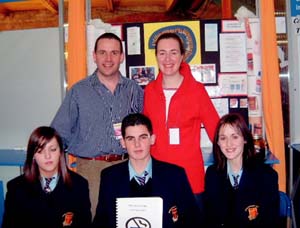| 2004 |

|
YEAR BOOK |
Moyne Community School, Longford
|
Teenage smokers – can they stop?
|

By means of a whole school survey, we determined the incidence of smoking, reasons for smoking and desire to quit. We then set about designing a peer led six-week Smoking Cessation Programme. It offered both support and information to students wishing to quit smoking. By means of a 'Readiness to change line', we identified those in the contemplative stage of the Cycle of Change. Participating students attended six weekly one-hour sessions. A 'Control Group' was formed who did not attend the sessions but attempted to quit by will power alone.
The skills, advice and methodologies used were learned at a Smoking Cessation Training Workshop facilitated by the Department of Preventive Medicine and Health Promotion at St Vincent's University Hospital, Dublin, in conjunction with the Irish Cancer Society.
Throughout the six weeks, the programme content was assessed and adapted to meet the needs of the participating students, particularly conscious of age, gender, level of interest and appropriateness of materials. Participants were guided through a series of changes – namely: Contemplation, Preparation, Action, Maintenance and Established Change, in accordance with the Prochaska Di Clementi model 'Cycle of change'.
Ms Kathleen Griffin, Smoking Cessation Officer, Midland Health Board, attended one session, after which she offered professional assessment, advice and support. Participants' and the control group's progress were monitored using methodologies including questionnaires, 'Readiness to change lines', diary keeping, breath CO ppm, and blood % COHb readings.
On completion of the programme, the principle findings were that 36% had successfully ceased smoking, 58% had cut down dramatically, while 6% had relapsed showing signs of progressing back to the contemplation stage again. The results of the control group showed a marked difference, initially showing a habit decrease in the first three weeks, but by the end of the six-week period, they were smoking in their normal pattern again.
We posed the question in our title 'Teenage Smokers – can they stop?' The answer is YES!, with a Peer Led Smoking Cessation Programme.
Christina Hannify, Raymond Galligan & Angela Mulligan entered their project in the Senior Group Section in the Social and Behavioural Sciences Category at the EsatBT Young Scientist & Technology Exhibition in January 2004. They won one of the top prizes – Runner-Up Group Award. They also won a Special Award sponsored by ASH Ireland. Their teachers were Ms Louise Killian and Rev. Declan Shannon.
| This article was sponsored by ASH Ireland |
|---|